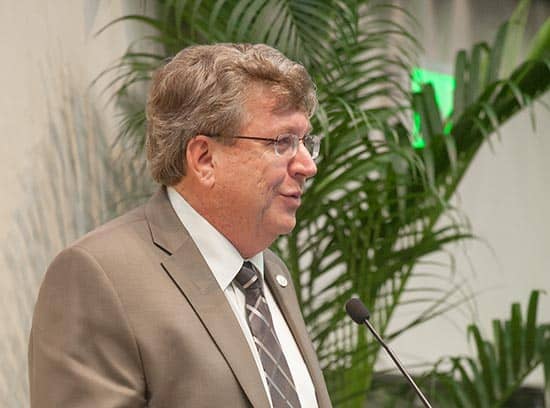
BitDepth#963 for November 18

Professor Eric Fossum, inventor of the CMOS sensor chip, speaks at the UWI Open Lecture last week at the Faculty of Engineering. Photograph by Mark Lyndersay.
Professor Eric R Fossum is probably the most important man in the world of modern photography, but he almost walked right past me without my knowing it.
Lost on my way to the lecture he was scheduled to give last Monday, I spotted an old school friend, who also happened to be the Chair of the Open Lectures Committee that brought Professor Fossum to T&T.
In an uncharacteristic moment of mental agility, I deduced that the person ambling along beside him had to be the feature speaker. As the professor gripped my hand firmly after introductions, he quietly said, “Thanks for coming to the lecture.”
“Huh,” I might have said if I were forty years younger, “as if.”
Professor Fossum is the scientist who leveraged the groundbreaking charge-coupled device (CCD) technology that underpins almost all modern visual telecommunications to create a more energy efficient and ultimately more scalable revision called complementary metal-oxide-semiconductor or CMOS technology.
Moore’s Law, the axiom that’s rather efficiently predicted the rate of technological progress (it doubles every year), has been kind to these light gathering technologies, In 1971, it was possible to put 2.3 light gathering sensors on a chip, now transistors are packing in up to 2.6 billion of them.
The learned professor quickly powered through the technical part of his presentation, a dense thing made of high level physics and some folksy characterisations of his invention.
“Light is a wave,” he noted as a slide came up, “but light is sometimes also a particle.”
This was the sort of thing that always drove me a little loopy in science class and at this level, with discussions that reference “photon shot noise” and “the Poisson Process,” things were drifting firmly in the direction of hard science. One sentence peeped through, however, a mention that scientists seem to be agreeing that we are approaching the limits of physics when it comes to pixel sizes.
Pixels, or picture elements, are the tiny light sensitive sites packed onto a camera’s sensor that actually capture the light representing your photo and translate it into the electrical impulses that become the bits of an image.
Professor Fossum began his work on the technology that would become the CMOS sensor at NASA’s Jet Propulsion Laboratory, where he was charged with making digital capture devices that were smaller, lighter and more energy efficient to fit into the smaller spacecraft that the space agency was building.
Galileo launched in 1989 with an 800 x 800 pixel sensor, but in 1992, the Professor’s team developed Intrapixel Change Transfer, a method of reducing noise and amplifying signal. This began the era of a camera system on a chip, where the chip itself carried the technologies needed to decode the light it was capturing.
His work having arrived at a satisfactory stage for NASA’s needs, JPL took the next step with its discovery and began the process of developing technology development agreements with the giants of the day, AT&T, Kodak, Schick Technologies and Bell Labs through CalTech.
The technology transfer proved slow and required constant intervention by the team at JPL, so NASA took the uncommon step in 1995 of allowing the frustrated team to license their invention and market it as Photobit.
Photobit ran as a self-funded concern from 1995-2001, fueled by design contracts with private industry and filed 100 new patents on imaging technologies. It was acquired by Micron Technologies in 2001 and the intellectual assets reverted to CalTech, but by then, 30 companies were working on CMOS based technologies.
“A patent never stops anyone from stealing your idea,” Professor Fossum noted wryly, “but you may be able to make them pay.”
Today, Sony and Samsung are the world leaders in CMOS chip production, ranked at one and two respectively and two billion digital cameras are being produced every year, roughly 60 cameras per second.
CalTech has successfully enforced its patents against multiple players and now the story is coming full circle, and NASA is now using the technology in space.
As Professor Fossum gets ready for his third retirement, he is fascinated by the impact of imaging technology, which he has seen bring new social issues, visual overload, rapid social change, instant communication and some inappropriate use since its introduction.
He’s also working on a new technology, the Quanta Image Sensor (QIS), which promises to deliver digital images with a more film-like exposure, through capture sensors that respond to light more like traditional emulsions did, putting a billion sensors on a chip while pulling a watt of power.
But he’s also looking at the directions that computational imaging is taking, with technologies like light field technology (exemplified by the Lytro camera) inviting emphasis now.
“Understanding business isn’t rocket science,” he argues, “it’s a lot easier than engineering.”
“When there’s a need that people want satisfied, when you can answer, who is going to buy this. There is your opportunity.”
Looking back at his work with the CMOS sensor, he boiled his learnings down into five brief sentences.
- Create the invention.
- Successfully commercialise it.
- Deliver on the promise compellingly.
- Sell the company.
- Defend the patents.


